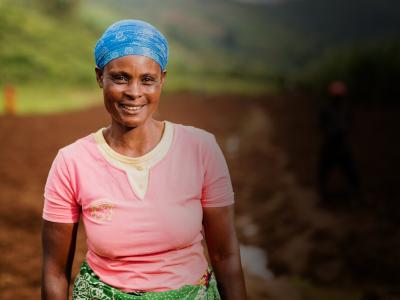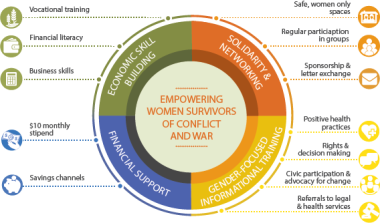Women for Women International aims to create a world in which every woman can determine the course of her life and reach her full potential. We have worked with half a million women across eight conflict-affected countries since 1993.
We serve the most marginalized women in conflict-affected countries – as they are the most at risk to be left behind – and help them move from isolation and poverty to self-sufficiency and empowerment.
Our intensive one-year empowerment program focuses on building knowledge, skills and resources in four key domains: earning and saving, health and well-being, rights and decision-making and support networks. Alongside this, we run complementary programs to engage men and community leaders and support local women leaders shift social norms.
Rigorous Global Research
To investigate its effects, our program in Afghanistan was chosen to be a part of the global research conducted by the What Works to Prevent Violence Against Women and Girls (VAWG) Programme, a flagship DFID programme investing an unprecedented £25 million over five years on the prevention of violence against women and girls.
The two-year long randomized controlled trial investigated how our program affected women’s income and savings, household wellbeing, gender equitable attitudes, and experiences of intimate partner violence (IPV). This independent, external evaluation found that our program improved the economic and social well-being of women survivors of war.
Challenges Faced by Afghan Women
With the confluence of gender inequality, instability and rising poverty, Afghanistan is one of the toughest places on earth to be a woman – and some studies suggest it may be the worst.
Before enrolling in our program, a survey with participants showed 37% of married women had experienced physical IPV, over 80% had never received any formal education, 70% had borrowed food or money because they did not have enough, and 57% had reported lifetime trauma exposure such as witnessing family or friends killed.
Key Lessons Learned
Sustained and Targeted Support Improves Lives of Women
The research showed that there was a significant impact on women’s social and economic well-being a year after graduating from our program. Compared to women who did not receive the intervention, women in the program were nearly twice as likely to be earning money and seven times more likely to have savings. Women in the program also experienced:
- More equitable gender attitudes
- Increased food security for their families
- Increased freedom to travel
- More decision-making power in their households
- Reduced IPV among those with moderate food insecurity, but did not reduce risk in overall population
We believe this success is based on key elements of our program:
- Targeting women and communities based on social and economic vulnerabilities
- Integrated social and economic empowerment approach
- Support to build women’s knowledge, skills and self-confidence
- Networks and connections with other women
- Engaging community leaders and male relatives
- Led by local women, who create direct and personal relationships with the women served
Potentially Reduced Risks for Increasing IPV
The study saw a reduction in married women’s experiences of IPV for a subset of women with moderate levels of food insecurity, but did not see a decrease for the overall study population. With some evidence suggesting women’s participation in economic empowerment can increase the risk of violence, it is encouraging that this intervention showed no increase of IPV. In fact, in Afghanistan’s worsening context for women, the program may have actually mitigated risks of increasing IPV.
The Road Ahead: More Intentional Programming to Reduce IPV
Although our current program isn’t designed specifically to prevent and respond to IPV, we recognize that IPV is a significant barrier to women’s social and economic participation. If we aim to directly influence IPV outcomes, more intentional programming is needed in the future. Since 2016 to 2018 when the program was evaluated, we’ve made program changes to engage men and launch activities to support local women leaders in shifting social norms. The research findings will continue to inform our organizational and program growth.
Women for Women International’s Program Works
This independent research demonstrates that Women for Women International’s intervention leads to significant positive changes in women’s social and economic empowerment. Additionally, the research provides lessons to help further refine the model to strengthen its effectiveness on reducing violence. As a global community, it is critical to learn from research, adapt programs for greater impact, and invest in rigorously tested solutions that can be implemented in multiple conflict-affected countries to change the course of the lives of millions of marginalized women – moving them from isolation and poverty to self-sufficiency and empowerment.
Acknowledgements
This intervention trial is a collaborative project of Women for Women International and the South African Medical Research Council (SAMRC). The research was led by Prof. Rachel Jewkes with Dr. Andrew Gibbs, Dr. Esnat Chirwa, and Dr. Julienne Corboz of SAMRC. This research was conducted under the What Works to Prevent Violence Against Women and Girls Global Programme funded by UK aid from the UK government. The views expressed in this brief are solely those of the authors and do not necessarily reflect those of the UK government.

